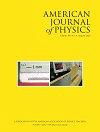二维磁球方形晶格中的无限折叠能量简并
IF 0.9
4区 教育学
Q3 EDUCATION, SCIENTIFIC DISCIPLINES
引用次数: 0
摘要
我们证明,可以通过将小型圆柱形钕磁体放置在塑料球壳内并将其漂浮在水上,使其磁矩在平面内自由重新定向,来研究二维方形磁体晶格。在实验中,最近邻居之间的反相关偶极取向似乎在能量上受到青睐。这促使为磁偶极子的2D正方形晶格构建简化的单变量能量函数。对于奇数个球体,这种模拟产生了具有相同能量的偶极配置的连续体,与观察到的偶极在这些晶格中的取向可以自由旋转的行为相匹配。具有偶数个球体的正方形晶格的行为有着惊人的不同,显示出强烈的偏好取向。虽然在这个简化模型中计算的能量大于有限大小团簇的实际基态的能量,但它在球体数量无穷大的极限下的渐近值与文献值非常一致。此外,在单变量能量函数的范畴内,分析了有缺陷和无缺陷磁球的矩形排列。简单的实验演示定性地再现了从所有这些分析中获得的几个有趣的结果。本文章由计算机程序翻译,如有差异,请以英文原文为准。
Infinite-fold energy degeneracy in 2D square lattices of magnetic spheres
We show that a two-dimensional square lattice of magnets can be studied by placing small cylindrical neodymium magnets inside plastic spherical shells and floating them on water, leaving their magnetic moments free to re-orient within the plane. Experimentally, anti-correlated dipole orientations between nearest neighbors appear to be favored energetically. This motivates the construction of a simplified single-variable energy function for a 2D square lattice of magnetic dipoles. For odd numbers of spheres, this ansatz yields a continuum of dipole configurations with the same energies, matching the observed behavior that the orientation of the dipoles in these lattices can be rotated freely. The behavior of square lattices with even numbers of spheres is strikingly different, showing strongly preferred orientations. While the energy calculated in this simplified model is larger than that of the actual ground state for finite size clusters, its asymptotic value in the limit where the number of spheres goes to infinity is in good agreement with the literature value. Additionally, rectangular arrangements of magnetic spheres with and without a defect are analyzed within the class of the single variable energy function. Simple experimental demonstrations qualitatively reproduce several interesting results obtained from all these analyses.
求助全文
通过发布文献求助,成功后即可免费获取论文全文。
去求助
来源期刊

American Journal of Physics
物理-物理:综合
CiteScore
1.80
自引率
11.10%
发文量
146
审稿时长
3 months
期刊介绍:
The mission of the American Journal of Physics (AJP) is to publish articles on the educational and cultural aspects of physics that are useful, interesting, and accessible to a diverse audience of physics students, educators, and researchers. Our audience generally reads outside their specialties to broaden their understanding of physics and to expand and enhance their pedagogical toolkits at the undergraduate and graduate levels.
 求助内容:
求助内容: 应助结果提醒方式:
应助结果提醒方式:


